NCERT Solutions for Class 12 Maths Chapter 13 - Probability - Exercise 13.5
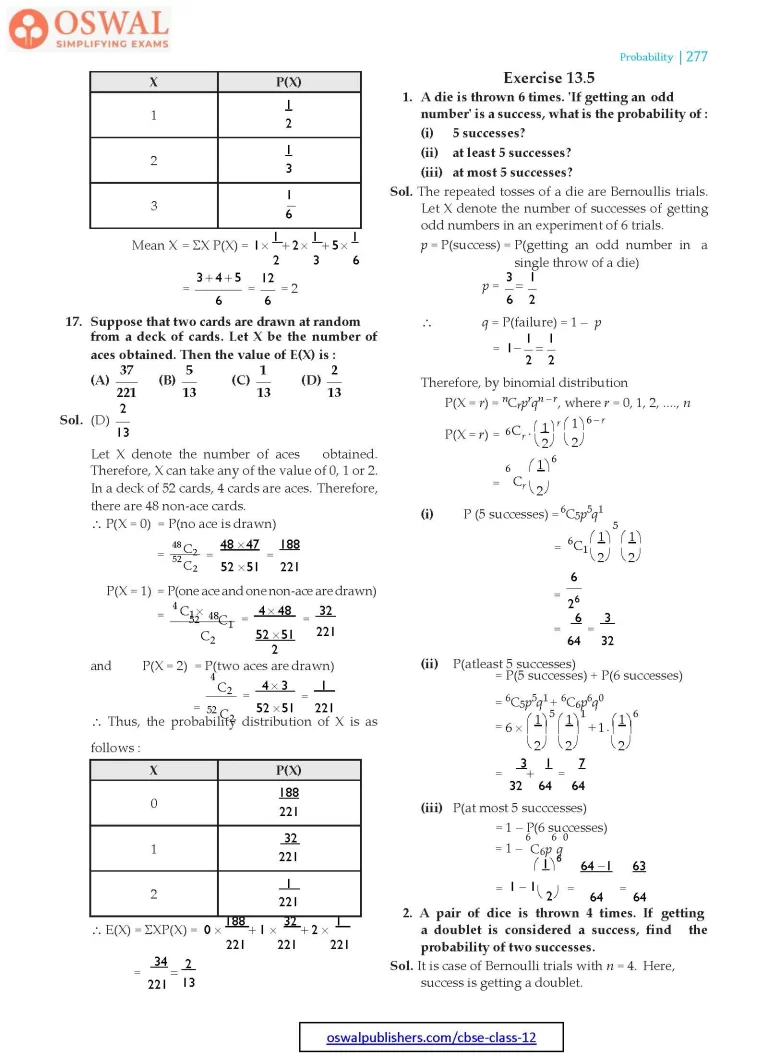
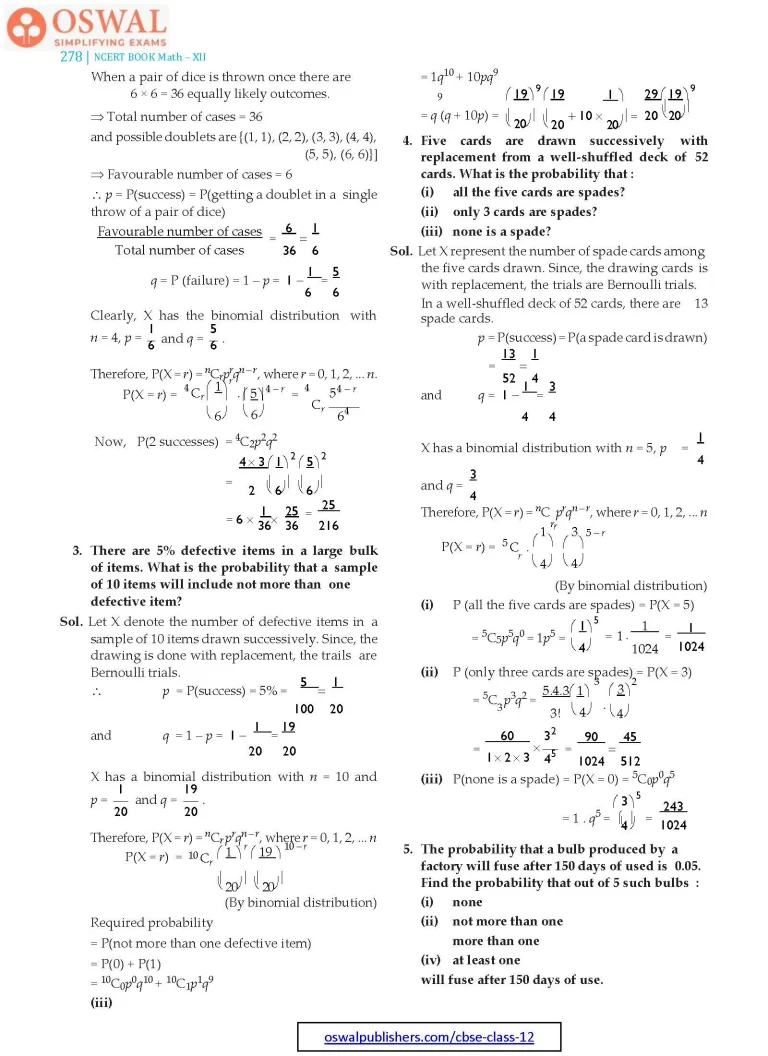
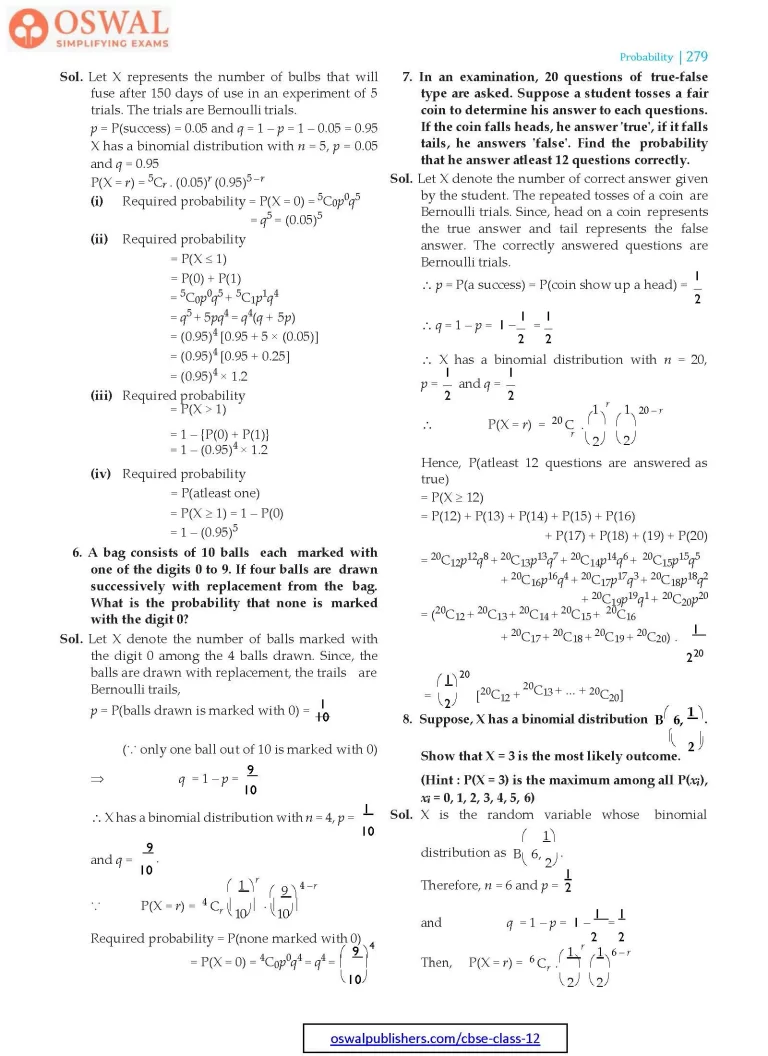
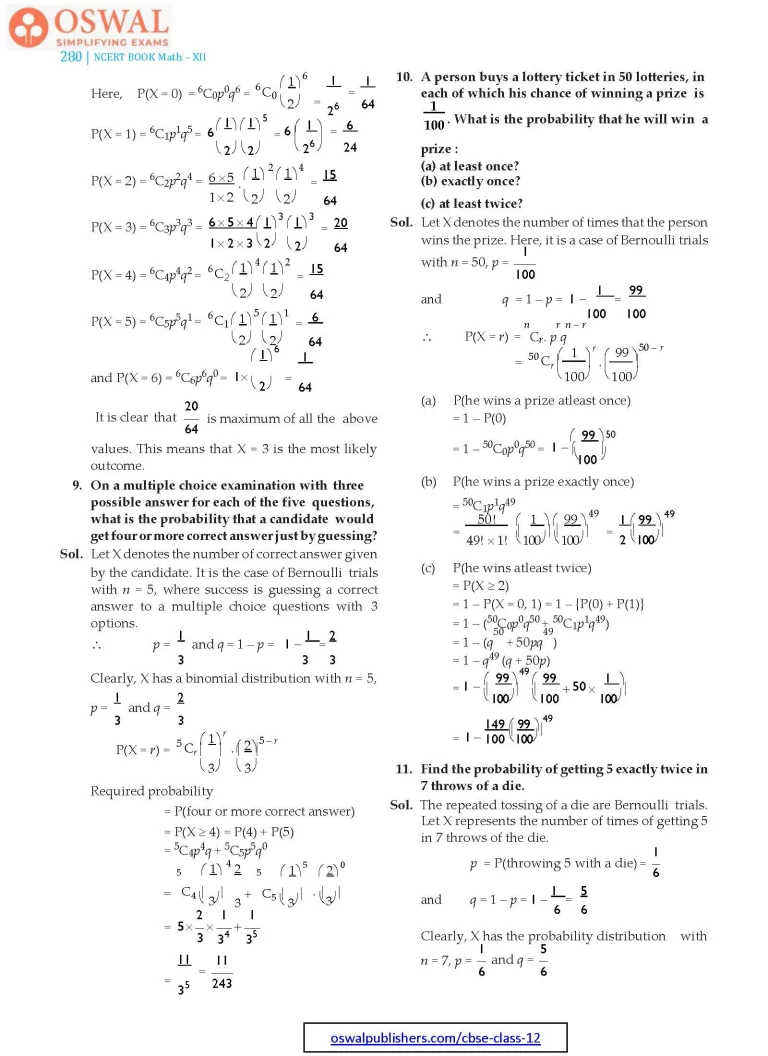
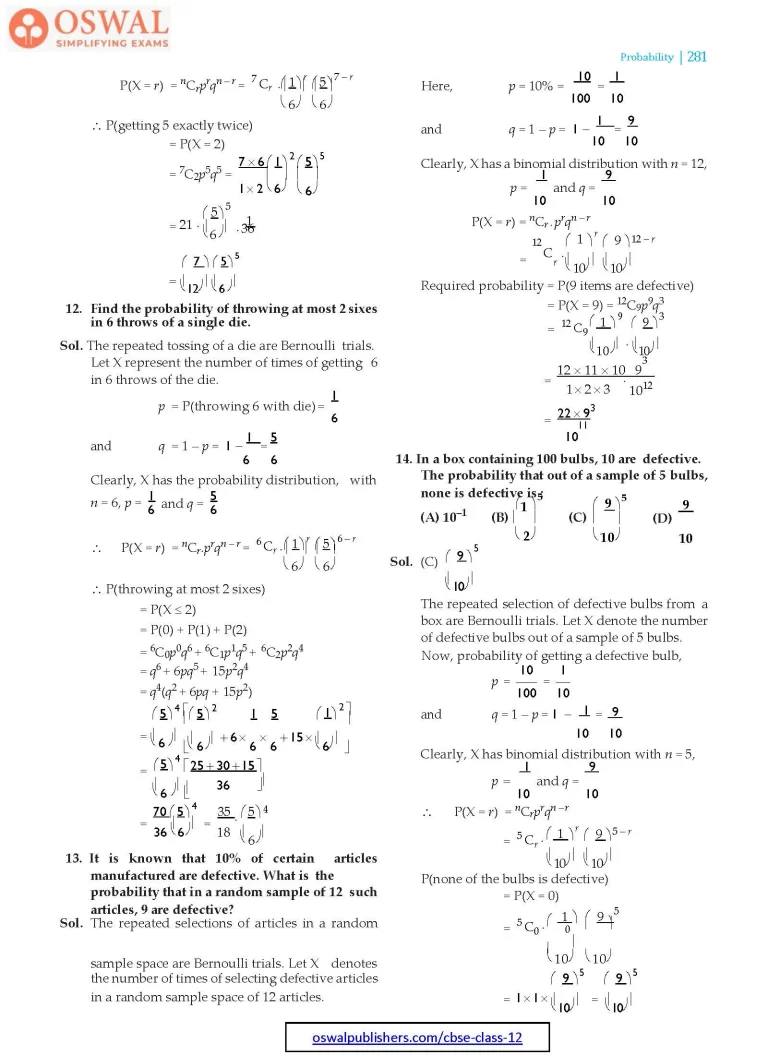
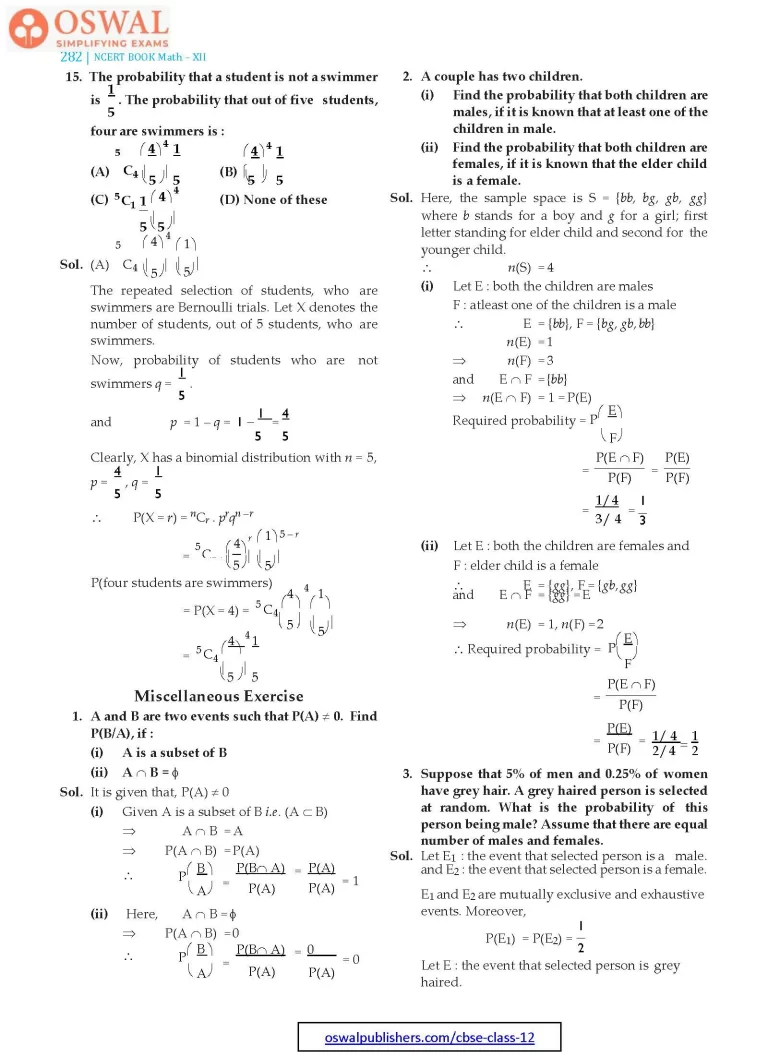
Access Exercises of Class 12 Maths Chapter 13 – Probability
Exercise 13.1 Solutions 17 Questions
Exercise 13.2 Solutions 18 Questions
Exercise 13.3 Solutions 14 Questions
Exercise 13.4 Solutions 17 Questions
Exercise 13.5 Solutions 15 Questions
Miscellaneous Exercise on Chapter 13 Solutions 10 Questions
Exercise 13.5
1. A die is thrown 6 times. 'If getting an odd number' is a success, what is the probability of :
(i) 5 successes?
(ii) at least 5 successes?
(iii) at most 5 successes?
Sol. The repeated tosses of a die are Bernoullis trials. Let X denote the number of successes of getting odd numbers in an experiment of 6 trials.
p = P(success) = P(getting an odd number in a single throw of a die)
$$p = \frac{3}{6} =\frac{1}{2}\\\therefore\space q =\text{P(failure)} \\= 1-p\\=1-\frac{1}{2} =\frac{1}{2}$$
Therefore, by binomial distribution
P(X = r) = nCrprqn – r, where r = 0, 1, 2, ...., n
$$\text{P(X = r)} = ^{6}\text{C}_{r}.\bigg(\frac{1}{2}\bigg)^{r}\bigg(\frac{1}{2}\bigg)^{6-r}\\ = ^{6}\text{C}_{r}\bigg(\frac{1}{2}\bigg)^{6}\\\textbf{(i)}\space\text{P (5 successes)} \\=^{6}\text{C}_5p^{5}q^{1}\\=^{6}\text{C}_1\bigg(\frac{1}{2}\bigg)^{5}\bigg(\frac{1}{2}\bigg)\\=\frac{6}{2^{6}}\\=\frac{6}{64} = \frac{3}{32}$$
(ii) P(atleast 5 successes)
= P(5 successes) + P(6 successes)
= 6C5p5q1 + 6C6p6q0
$$= 6 × \bigg(\frac{1}{2}\bigg)^{5}\bigg(\frac{1}{2}\bigg)^{1} + 1.\bigg(\frac{1}{2}\bigg)^{6}\\=\frac{3}{32} + \frac{1}{64} = \frac{7}{64}$$
(iii) P(at most 5 succcesses)
= 1 – P(6 successes)
= 1 – 6C6p6q0
$$= 1-1\bigg(\frac{1}{2}\bigg)^{6}\\=\frac{64-1}{64} =\frac{63}{64}$$
2. A pair of dice is thrown 4 times. If getting a doublet is considered a success, find the probability of two successes.
Sol. It is case of Bernoulli trials with n = 4. Here, success is getting a doublet.
When a pair of dice is thrown once there are
6 × 6 = 36 equally likely outcomes.
⇒ Total number of cases = 36
and possible doublets are {(1, 1), (2, 2), (3, 3), (4, 4), (5, 5), (6, 6)}]
⇒ Favourable number of cases = 6
∴ p = P(success) = P(getting a doublet in a single throw of a pair of dice)
$$\frac{\text{Favourable number of cases}}{\text{Total number of cases}}\\=\frac{6}{36} =\frac{1}{6}\\\text{q = P (failure)}\\=\text{1 - p} = 1-\frac{1}{6}=\frac{5}{6}$$
Clearly, X has the binomial distribution with
$$n=4, p =\frac{1}{6}\space\text{and q} =\frac{5}{6}.\\\text{Therefore, P(X = r)}= \space^nC_rp^rq^{n – r},\\\text{where r = 0, 1, 2, ... n.}\\\text{P(X=r)} =\\\space^{4}\text{C}_r\bigg(\frac{1}{6}\bigg)^{r}.\bigg(\frac{5}{6}\bigg)^{4-r}\\=\space^{4}\text{C}_r\frac{5^{4-r}}{6^{4}}$$
Now, P(2 successes) = 4C2p2q2
$$= \frac{4×3}{2}\bigg(\frac{1}{6}\bigg)^{2}\bigg(\frac{5}{6}\bigg)^{2}\\= 6×\frac{1}{36}×\frac{25}{36}=\frac{25}{216}$$
3. There are 5% defective items in a large bulk of items. What is the probability that a sample of 10 items will include not more than one defective item?
Sol. Let X denote the number of defective items in a sample of 10 items drawn successively. Since, the drawing is done with replacement, the trails are Bernoulli trials.
$$\therefore\space \text{p = P(success)} = 5\%\\=\frac{5}{100}=\frac{1}{20}\\\text{and}\space q = 1-p = 1-\frac{1}{20}=\frac{19}{20}$$
X has a binomial distribution with n = 10 and
$$p = \frac{1}{20}\text{and q} =\frac{19}{20}. $$
Therefore, P(X = r) = nCr prqn – r, where r = 0, 1, 2, ... n
$$\text{P(X = r)} = ^{10}\text{C}_{r}\bigg(\frac{1}{20}\bigg)^{r}\bigg(\frac{19}{20}\bigg)^{10-r}$$
(By binomial distribution)
Required probability
= P(not more than one defective item)
= P(0) + P(1)
= 10C0p0q10 + 10C1p1q9
= 1q10 + 10pq9
$$= q^{9}(q + 10p) =\bigg(\frac{19}{20}\bigg)^{9}\\\bigg(\frac{19}{20} + 10×\frac{1}{2}\bigg)\\=\frac{29}{20}\bigg(\frac{19}{20}\bigg)^{9}$$
4. Five cards are drawn successively with replacement from a well-shuffled deck of 52 cards. What is the probability that :
(i) all the five cards are spades?
(ii) only 3 cards are spades?
(iii) none is a spade?
Sol. Let X represent the number of spade cards among the five cards drawn. Since, the drawing cards is with replacement, the trials are Bernoulli trials.
In a well-shuffled deck of 52 cards, there are 13 spade cards.
p = P(success) = P(a spade card is drawn)
$$=\frac{13}{52} =\frac{1}{4}\\\text{and}\space q = 1-\frac{1}{4} = \frac{3}{4} $$
X has a binomial distribution with n = 5,
$$p = \frac{1}{4}\text{and}\space q =\frac{3}{4}$$
Therefore, P(X = r) = nCr prqn – r, where r = 0, 1, 2, ... n
$$\text{P}(X=r) =^{5}\text{C}_{r}.\bigg(\frac{1}{4}\bigg)^{r}\bigg(\frac{3}{4}\bigg)^{5-r}$$
(By binomial distribution)
(i) P (all the five cards are spades) = P(X = 5)
$$= \space^5C_5p^5q^0 = 1p^5 =\bigg(\frac{1}{4}\bigg)^{5}\\=1.\frac{1}{1024} =\frac{1}{1024}$$
(ii) P (only three cards are spades) = P(X = 3)
$$=\space^{5}\text{C}_{3}p^{3}q^{2}= \frac{5.4.3}{3!}\bigg(\frac{1}{4}\bigg)^{3}.\bigg(\frac{3}{4}\bigg)^{2}\\=\frac{60}{1×2×3}×\frac{3^{2}}{4^{5}}\\=\frac{90}{1024}=\frac{45}{512}$$
(iii) P(none is a spade) = P(X = 0) = 5C0p0q5
$$= 1.q^{5}=\bigg(\frac{3}{4}\bigg)^{5} =\frac{243}{1024}$$
5. The probability that a bulb produced by a factory will fuse after 150 days of used is 0.05. Find the probability that out of 5 such bulbs :
(i) none
(ii) not more than one
(iii) more than one
(iv) at least one
will fuse after 150 days of use.
Sol. Let X represents the number of bulbs that will fuse after 150 days of use in an experiment of 5 trials. The trials are Bernoulli trials.
p = P(success) = 0.05 and q = 1 – p = 1 – 0.05 = 0.95
X has a binomial distribution with n = 5, p = 0.05 and q = 0.95
P(X = r) = 5Cr . (0.05)r (0.95)5 – r
(i) Required probability = P(X = 0) = 5C0p0q5
= q5 = (0.05)5
(ii) Required probability
= P(X ≤ 1)
= P(0) + P(1)
= 5C0p0q5 + 5C1p1q4
= q5 + 5pq4 = q4(q + 5p)
= (0.95)4 [0.95 + 5 × (0.05)]
= (0.95)4 [0.95 + 0.25]
= (0.95)4 × 1.2
(iii) Required probability
= P(X > 1)
= 1 – {P(0) + P(1)}
= 1 – (0.95)4 × 1.2
(iv) Required probability
= P(atleast one)
= P(X ≥ 1) = 1 – P(0)
= 1 – (0.95)5
6. A bag consists of 10 balls each marked with one of the digits 0 to 9. If four balls are drawn successively with replacement from the bag. What is the probability that none is marked with the digit 0?
Sol. Let X denote the number of balls marked with the digit 0 among the 4 balls drawn. Since, the balls are drawn with replacement, the trails are Bernoulli trails,
$$\text{p = P(balls drawn is}\\\text{marked with 0) =}\frac{1}{10}$$
(∵ only one ball out of 10 is marked with 0)
$$\Rarr\space q = 1-p =\frac{9}{10}\\\therefore\space\text{X has a binomial distribution}\\\text{with n = 4, p =}\frac{1}{10}\space\text{and}\space q=\frac{9}{10}.\\\because\space\text{P(X = r)} =\space^{4}\text{C}_r\bigg(\frac{1}{10}\bigg)^{r}.\bigg(\frac{9}{10}\bigg)^{4-r}$$
Required probability = P(none marked with 0)
$$= \text{P(X=0)} = \space^{4}\text{C}_{0}p^{0}q^{4} \\= q^{4}=\bigg(\frac{9}{10}\bigg)^{4}$$
7. In an examination, 20 questions of true-false type are asked. Suppose a student tosses a fair coin to determine his answer to each questions. If the coin falls heads, he answer 'true', if it falls tails, he answers 'false'. Find the probability that he answer atleast 12 questions correctly.
Sol. Let X denote the number of correct answer given by the student. The repeated tosses of a coin are Bernoulli trials. Since, head on a coin represents the true answer and tail represents the false answer. The correctly answered questions are Bernoulli trials.
$$\therefore\space\text{p = P(a success)} \\= \text{P}(\text{coin show up a head})=\frac{1}{2}\\\therefore\space q=1-p=1-\frac{1}{2} =\frac{1}{2}$$
∴ X has a binomial distribution with n = 20,
$$p=\frac{1}{2}\space\text{and} \space q=\frac{1}{2}\\\therefore\space\text{P}(X=r) = \\\space^{20}\text{C}_{r}.\bigg(\frac{1}{2}\bigg)^{r}\bigg(\frac{1}{2}\bigg)^{20-r}$$
Hence, P(atleast 12 questions are answered as true)
= P(X ≥ 12)
= P(12) + P(13) + P(14) + P(15) + P(16) + P(17) + P(18) + (19) + P(20)
$$= \space^{20}\text{C}_{12}p^{12}q^{8} + \space^{20}\text{C}_{13}p^{13}q^{7} +\\{^{20}\text{C}_{14}p^{14}q^{6}+^{20}\text{C}_{15}p^{15}q^{5} +}\\{^{20}\text{C}_{16}p^{16}q^{4} + ^{20}\text{C}_{17}p^{17}q^{3} + ^{20}\text{C}_{18}p^{18}q^{2}}+\\{^{20}\text{C}_{19}p^{19}q^{1} + ^{20}\text{C}_{20}p^{20}}\\=(^{20}\text{C}_{12} + ^{20}\text{C}_{13} + ^{20}\text{C}_{14}+^{20}\text{C}_{15} + ^{20}\text{C}_{16}\\ + ^{20}\text{C}_{17} + ^{20}\text{C}_{18}\\ + ^{20}\text{C}_{19} + ^{20}\text{C}_{20}).\frac{1}{2^{20}}$$
$$=\bigg(\frac{1}{2}\bigg)^{20}\lbrack^{20}\text{C}_{12} + ^{20}\text{C}_{13} + ... + ^{20}\text{C}_{20}\rbrack$$
8. Suppose, X has a binomial distribution
$$\textbf{B}\bigg(\textbf{6},\frac{\textbf{1}}{\textbf{2}}\bigg)$$
Show that X = 3 is the most likely outcome.
(Hint : P(X = 3) is the maximum among all P(xi), xi = 0, 1, 2, 3, 4, 5, 6)
Sol. X is the random variable whose binomial distribution as
$$\textbf{B}\bigg(6,\frac{1}{2}\bigg).\\\text{Therefore, n = 6 and}\space p=\frac{1}{2}\\\text{and}\space q = 1-p = 1-\frac{1}{2} =\frac{1}{2}\\\text{Then,}\space\text{P}(X=r) \\= ^{6}\text{C}_{r}.\bigg(\frac{1}{2}\bigg)^{r}\bigg(\frac{1}{2}\bigg)^{6-r}$$
Here, P(X = 0) = 6C0p0q6 =
$$=\space^{6}\text{C}_0\bigg(\frac{1}{2}\bigg)^{6} = \frac{1}{2^{6}} =\frac{1}{64}$$
P(X = 1) = 6C1p1q5
$$= 6\bigg(\frac{1}{2}\bigg)\bigg(\frac{1}{2}\bigg)^{5} = \\6\bigg(\frac{1}{2^6}\bigg) = \frac{6}{24}$$
P(X = 2) = 6C2p2q4
$$=\frac{6×5}{1×2}.\bigg(\frac{1}{2}\bigg)^{2}\bigg(\frac{1}{2}\bigg)^{4} =\frac{15}{64}$$
P(X = 3) = 6C3p3q3
$$= \frac{6×5×4}{1×2×3}\bigg(\frac{1}{2}\bigg)^{3}\bigg(\frac{1}{2}\bigg)^{3}\\=\frac{20}{64}$$
P(X = 4) = 6C4p4q2 =
$$^{6}\text{C}_{2}\bigg(\frac{1}{2}\bigg)^{4}\bigg(\frac{1}{2}\bigg)^{2} = \frac{15}{64}$$
P(X = 5) = 6C5p5q1
$$=\space^{6}\text{C}_{1}\bigg(\frac{1}{2}\bigg)^{5}\bigg(\frac{1}{2}\bigg)^{1} = \frac{6}{64}\\\text{and}\space \text{P (X = 6)} = \space^{6}\text{C}_{6}p^{6}q^{0}\\=1×\bigg(\frac{1}{2}\bigg)^{6} = \frac{1}{64}$$
$$\text{It is clear that}\space\frac{20}{64}\space\text{is}\\\text{maximum of all the above values.}$$
This means that X = 3 is the most likely outcome.
9. On a multiple choice examination with three possible answer for each of the five questions, what is the probability that a candidate would get four or more correct answer just by guessing?
Sol. Let X denotes the number of correct answer given by the candidate. It is the case of Bernoulli trials with n = 5, where success is guessing a correct answer to a multiple choice questions with 3 options.
$$\therefore\space p = \frac{1}{3}\text{and}\space q=1-p\\1 -\frac{1}{3} =\frac{2}{3}$$
Clearly, X has a binomial distribution with n = 5,
$$p=\frac{1}{3}\text{and q}=\frac{2}{3}\\\text{P}(X=r) = ^{5}\text{C}_{r}\bigg(\frac{1}{3}\bigg)^{r}.\bigg(\frac{2}{3}\bigg)^{5-r}$$
Required probability
= P(four or more correct answer)
= P(X ≥ 4) = P(4) + P(5)
= 5C4p4q + 5C5p5q0
$$=\space^{5}\text{C}_{4}\bigg(\frac{1}{3}\bigg)^{4}\frac{2}{3} + \space^{5}\text{C}_{5}\bigg(\frac{1}{3}\bigg)^{5}.\bigg(\frac{2}{3}\bigg)^{0}\\= 5×\frac{2}{3}×\frac{1}{3^{4}}+\frac{1}{3^{5}}\\=\frac{11}{3^{5}} = \frac{11}{243}$$
10. A person buys a lottery ticket in 50 lotteries, in each of which his chance of winning a prize is
$$\frac{\textbf{1}}{\textbf{100}}\textbf{.}\space\textbf{What is the probability}\\\textbf{that he will win a prize :}$$
(a) at least once?
(b) exactly once?
(c) at least twice?
Sol. Let X denotes the number of times that the person wins the prize. Here, it is a case of Bernoulli trials
$$\text{with n = 50, p =}\frac{1}{100}\\\text{and}\space \text{q-1-p = }1-\frac{1}{100}=\frac{99}{100}$$
∴ P(X = r) = nCr. prqn – r
$$=^{50}\text{C}_{r}\bigg(\frac{1}{100}\bigg)^{r}.\bigg(\frac{99}{100}\bigg)^{50\normalsize-r}$$
(a) P(he wins a prize atleast once)
= 1 – P(0)
= 1 – 50C0p0q50
$$= 1-\bigg(\frac{99}{100}\bigg)^{50}$$
(b) P(he wins a prize exactly once)
= 50C1p1q49
$$= \frac{50!}{49!×1!}\bigg(\frac{1}{100}\bigg)\bigg(\frac{99}{100}\bigg)^{49}\\=\frac{1}{2}\bigg(\frac{99}{100}\bigg)^{49}$$
(c) P(he wins atleast twice)
= P(X ≥ 2)
= 1 – P(X = 0, 1) = 1 – {P(0) + P(1)}
= 1 – (50C0p0q50 + 50C1p1q49)
= 1 – (q50 + 50pq49)
= 1 – q49 (q + 50p)
$$= 1 - \bigg(\frac{99}{100}\bigg)^{49}\bigg(\frac{99}{100}+50×\frac{1}{100}\bigg)\\= 1-\frac{149}{100}\bigg(\frac{99}{100}\bigg)^{49}$$
11. Find the probability of getting 5 exactly twice in 7 throws of a die.
Sol. The repeated tossing of a die are Bernoulli trials. Let X represents the number of times of getting 5 in 7 throws of the die.
$$\text{p = P(throwing 5 with a die) =}\frac{1}{6}\\\text{and\space} q = 1-p=1-\frac{1}{6} =\frac{5}{6}$$
Clearly, X has the probability distribution with
$$\text{n = 7}, p =\frac{1}{6}\text{and q} =\frac{5}{6}$$
P(X = r) = nCrprqn – r
$$=\space^{7}\text{C}_{r}.\bigg(\frac{1}{6}\bigg)^{r}\bigg(\frac{5}{6}\bigg)^{7-r}$$
∴ P(getting 5 exactly twice)
= P(X = 2)
$$= \space^{7}\text{C}_{2}p^{5}q^{5} \\=\frac{7×6}{1×2}\bigg(\frac{1}{6}\bigg)^{2}\bigg(\frac{5}{6}\bigg)^{5}\\= 21.\bigg(\frac{5}{6}\bigg)^{5}.\frac{1}{36}\\=\bigg(\frac{7}{12}\bigg)\bigg(\frac{5}{6}\bigg)^{5}$$
12. Find the probability of throwing at most 2 sixes in 6 throws of a single die.
Sol. The repeated tossing of a die are Bernoulli trials. Let X represent the number of times of getting 6 in 6 throws of the die.
p = P(throwing 6 with die)
$$=\frac{1}{6}\\\text{and}\space\text{q-1-p} = 1-\frac{1}{6}=\frac{5}{6}$$
Clearly, X has the probability distribution, with
$$n=6, p=\frac{1}{6}\text{and}\space q = \frac{5}{6}\\\therefore\space\text{P(X=r) =}^{n}\text{C}_{r}p^{r}q^{n-r}\\=\space^{6}\text{C}_{r}.\bigg(\frac{1}{6}\bigg)^{r}\bigg(\frac{5}{6}\bigg)^{6-r}$$
∴ P(throwing at most 2 sixes)
= P(X ≤ 2)
= P(0) + P(1) + P(2)
= 6C0p0q6 + 6C1p1q5 + 6C2p2q4
= q6 + 6pq5 + 15p2q4
= q4(q2 + 6pq + 15p2)
$$=\bigg(\frac{5}{6}\bigg)^{4}\begin{bmatrix}\bigg(\frac{5}{6}\bigg)^{2} + 6×\frac{1}{6}×\\\frac{5}{6}+15×\bigg(\frac{1}{6}\bigg)^{2}\end{bmatrix}\\=\bigg(\frac{5}{6}\bigg)^{4}\bigg[\frac{25+30+15}{36}\bigg]\\=\frac{70}{36}\bigg(\frac{5}{6}\bigg)^{4} =\frac{35}{18}.\bigg(\frac{5}{6}\bigg)^{4}$$
13. It is known that 10% of certain articles manufactured are defective. What is the probability that in a random sample of 12 such articles, 9 are defective?
Sol. The repeated selections of articles in a random sample space are Bernoulli trials. Let X denotes the number of times of selecting defective articles in a random sample space of 12 articles.
$$\text{Here}\space\text{p = 10\%} \\=\frac{10}{100} = \frac{1}{10}\\\text{and}\space\text{q = 1-p} = 1-\frac{1}{10} = \frac{9}{10}$$
Clearly, X has a binomial distribution with n = 12,
$$p =\frac{1}{10}\text{and q} = \frac{9}{10}$$
P(X = r) = nCr . prqn – r
$$= \space^{12}\text{C}_{r}.\bigg(\frac{1}{10}\bigg)^{r}\bigg(\frac{9}{10}\bigg)^{12-r}$$
Required probability = P(9 items are defective)
= P(X = 9) = 12C9p9q3
$$= \space^{12}\text{C}_{9}\bigg(\frac{1}{10}\bigg)^{9}.\bigg(\frac{9}{10}\bigg)^{3}\\=\frac{12×11×10}{1×2×3}.\frac{9^{3}}{10^{12}}\\=\frac{22×9^{3}}{10^{11}}$$
14. In a box containing 100 bulbs, 10 are defective. The probability that out of a sample of 5 bulbs, none is defective is :
$$\textbf{(A)\space 10}^{\normalsize-1}\\\textbf{(B)}\space\bigg(\frac{\textbf{1}}{\textbf{2}}\bigg)^{\textbf{5}}\\\textbf{(C)\space}\bigg(\frac{\textbf{9}}{\textbf{10}}\bigg)^{5}\\\textbf{(D)\space}\frac{\textbf{9}}{\textbf{10}}\\\textbf{Sol.}\space\text{(C)}\bigg(\frac{9}{10}\bigg)^{5}$$
The repeated selection of defective bulbs from a box are Bernoulli trials. Let X denote the number of defective bulbs out of a sample of 5 bulbs.
Now, probability of getting a defective bulb,
$$p = \frac{10}{100}=\frac{1}{10}\\\text{and}\space q=1-p\\=1-\frac{1}{10}=\frac{9}{10}$$
Clearly, X has binomial distribution with n = 5,
$$p =\frac{1}{10}\text{and q} =\frac{9}{10}\\\therefore\space \text{P}(X=r) = \space^{n}\text{C}_{r}p^{r}q^{n-r}\\=\space^{5}\text{C}_{r}.\bigg(\frac{1}{10}\bigg)^{r}\bigg(\frac{9}{10}\bigg)^{5-r}$$
P(none of the bulbs is defective)
= P(X = 0)
$$= \space^{5}\text{C}_{0}.\bigg(\frac{1}{10}\bigg)^{0}\bigg(\frac{9}{10}\bigg)^{5}\\ = 1×1×\bigg(\frac{9}{10}\bigg)^{5}=\bigg(\frac{9}{10}\bigg)^{5}$$
15. The probability that a student is not a swimmer is
$$\frac{\textbf{1}}{\textbf{5}}\textbf{.}\space\textbf{The probability that out of}$$
five students, four are swimmers is :
$$\textbf{(A)\space}^{\textbf{5}}\textbf{C}_{\textbf{4}}\bigg(\frac{\textbf{4}}{\textbf{5}}\bigg)^{\textbf{4}}\frac{\textbf{1}}{\textbf{5}}\\\textbf{(B)\space}\bigg(\frac{\textbf{4}}{\textbf{5}}\bigg)^{\textbf{4}}\frac{\textbf{1}}{\textbf{5}}\\\textbf{(C)\space}^{\textbf{5}}\textbf{C}_{\textbf{1}}\frac{\textbf{1}}{\textbf{5}}\bigg(\frac{\textbf{4}}{\textbf{5}}\bigg)^{4}\\\textbf{(D)}\space\textbf{None of these}\\\textbf{Sol.\space}\text{(A)\space}^{5}\text{C}_{4}\bigg(\frac{4}{5}\bigg)^{4}\bigg(\frac{1}{5}\bigg)$$
The repeated selection of students, who are swimmers are Bernoulli trials. Let X denotes the number of students, out of 5 students, who are swimmers.
Now, probability of students who are not swimmers
$$q = \frac{1}{5}\\\text{and}\space \text{p = 1-q}\\=1-\frac{1}{5}= \frac{4}{5}$$
Clearly, X has a binomial distribution with n = 5,
$$p =\frac{4}{5}, q=\frac{1}{5}\\\therefore\space\text{P}(X=r) = \space^{n}\text{C}_{r}.p^{r}q^{n-r}\\=\space^{5}\text{C}_{r}.\bigg(\frac{4}{5}\bigg)^{r}\bigg(\frac{1}{5}\bigg)^{5-r}$$
P(four students are swimmers)
$$\text{P(X=4)}= \space^{5}\text{C}_{4}\bigg(\frac{4}{5}\bigg)^{4}\bigg(\frac{1}{5}\bigg)\\=\space^{5}\text{C}_{4}\bigg(\frac{4}{5}\bigg)^{4}\frac{1}{5}$$
Share page on
NCERT Solutions Class 12 Mathematics
- Chapter 1 Relations and Functions
- Chapter 2 Inverse Trigonometric Functions
- Chapter 3 Matrices
- Chapter 4 Determinants
- Chapter 5 Continuity and Differentiability
- Chapter 6 Application of Derivatives
- Chapter 7 Integrals
- Chapter 8 Applications of the Integrals
- Chapter 9 Differential Equations
- Chapter 10 Vectors
- Chapter 11 Three-Dimensional Geometry
- Chapter 12 Linear Programming
- Chapter 13 Probability
CBSE CLASS 12 NCERT SOLUTIONS
- NCERT Solutions Class 12 English Core
- NCERT Solutions Class 12 Physics
- NCERT Solutions Class 12 Chemistry
- NCERT Solutions Class 12 Biology
- NCERT Solutions Class 12 Business Studies
- NCERT Solutions Class 12 Mathematics
- NCERT Solutions Class 12 Accountancy
- NCERT Solutions Class 12 Economics
- NCERT Solutions Class 12 Geography
- NCERT Solutions Class 12 History
- NCERT Solutions Class 12 Political Science
CBSE CLASS 12 SYLLABUS
- CBSE Class 12 English core Syllabus
- CBSE Class 12 Mathematics Syllabus
- CBSE Class 12 Physics Syllabus
- CBSE Class 12 Chemistry Syllabus
- CBSE Class 12 Biology Syllabus
- CBSE Class 12 Accountancy Syllabus
- CBSE Class 12 Business Studies Syllabus
- CBSE Class 12 Economics Syllabus
- CBSE Class 12 History Syllabus
- CBSE Class 12 Geography Syllabus
- CBSE Class 12 Political science Syllabus
- CBSE Class 12 Sociology Syllabus
- CBSE Class 12 Psychology Syllabus
- CBSE Class 12 Physical education Syllabus
- CBSE Class 12 Applied mathematics Syllabus
- CBSE Class 12 History of Indian Arts Syllabus
CBSE CLASS 12 Notes
- CBSE Class 12 Physics Notes
- CBSE Class 12 Chemistry Notes
- CBSE Class 12 Biology Notes
- CBSE Class 12 Maths Notes
- CBSE Class 12 Accountancy Notes
- CBSE Class 12 Business Studies Notes
- CBSE Class 12 Economics Notes
- CBSE Class 12 History Notes
- CBSE Class 12 Geography Notes
- CBSE Class 12 Political Science Notes

